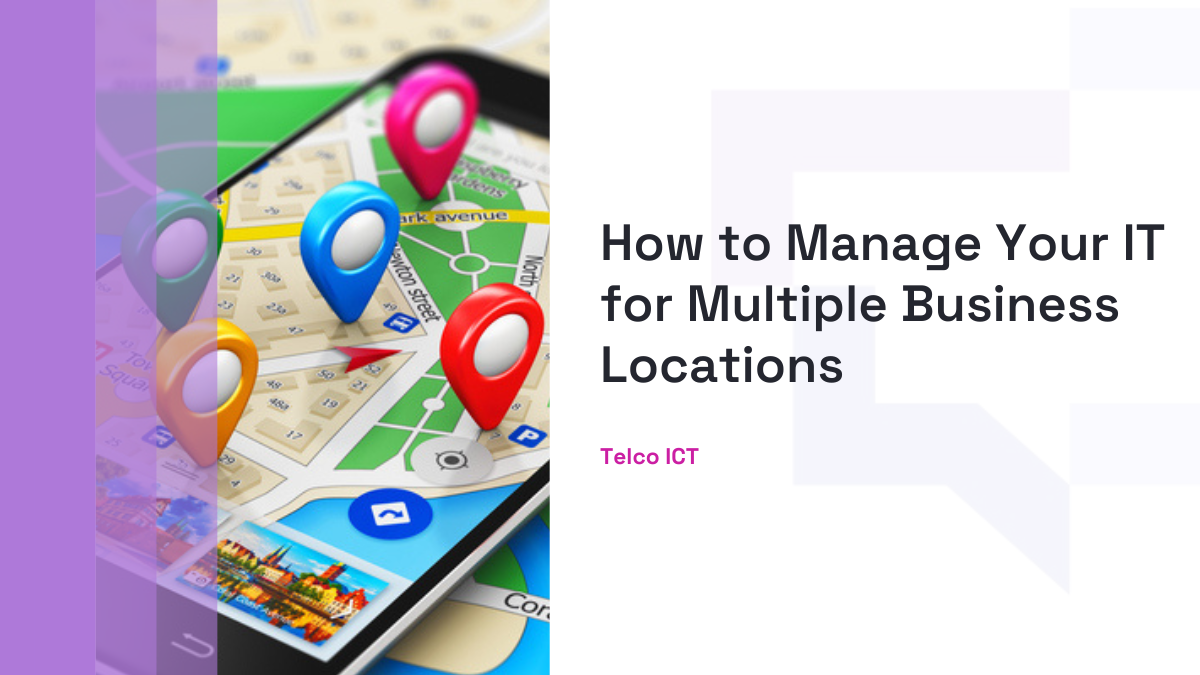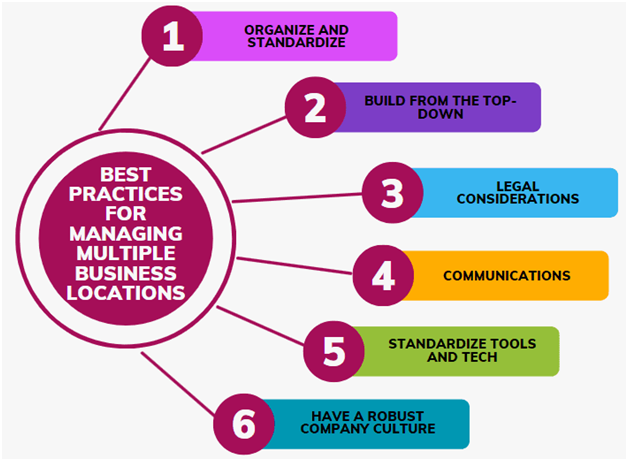
If you are reading this, then it indicates that your business is flourishing and you have expanded to various locations.
On the other hand, if you are looking to expand, there are a few important factors that you should consider to ensure that you get it right. Firstly, consider all the possible risks. Investing more in a new location entails paying more for:
- Technology
- Utilities
- Employees
- Materials
- Supplies
- Promotional activities
- Insurance, and more.
It also means you’ll be dividing your attention between your new and old tasks. You must pay close attention to your current business operations even while your new location demands a lot of your attention to ensure that nothing gets overlooked.
Well, as much as this expansion is a good thing for your business, it may not work efficiently for you, especially if you do not have the right IT solutions for multiple business locations.
But that’s not to mean that there is no way around it. Here are effective strategies for managing IT for multiple branches.
What is Multi-location IT Management?
Multi-location IT management refers to the process of overseeing and coordinating an organization’s information technology (IT) infrastructure and resources across multiple physical locations or branches. This type of IT management is crucial for businesses or institutions with operations spread across various geographic areas, such as multiple offices, retail outlets, manufacturing facilities, or remote workforces.
Multi-location IT management involves ensuring that all IT systems, hardware, software, network resources, and cybersecurity measures are consistent, reliable, and efficient across each location.
The major concepts in Multi-location IT Management include:
1. Centralized Control: By centralizing IT management, all locations’ IT resources are supervised and managed by a single IT team or department.
2. Network Connectivity: This is a crucial part because organizations with multiple locations require reliable and secure network connectivity.
3. Standardization: IT optimization for multi-location businesses helps maintain uniformity between sites and can be facilitated by standardizing technology, software, and IT rules.
4. Cloud Solutions: Cloud solutions are the new king of almost all tech operations. Therefore, leveraging cloud-based solutions allows organizations to store data and deploy applications that are accessible from any location.
5. Remote Monitoring and Management: By putting remote monitoring and management (RMM) solutions into place, IT administrators can keep an eye on the condition of IT systems at all times, troubleshoot problems remotely, and carry out maintenance duties.
6. Cybersecurity: A well-functioning system is of no use if the security is weak. Therefore, a robust cybersecurity strategy is crucial for multi-location IT management to protect sensitive data and systems.
7. Disaster Recovery and Backup: Organizations must develop comprehensive disaster recovery and backup plans that cover all locations.
Running a Multi-location Business: 5 Challenges and 5 IT Solutions
- Simplifying Communication
It’s even more important to keep communication simple and consistent when your company grows into new locations. Without a streamlined communication system, very many things would go wrong before anybody notices.
Therefore, considering the function of PBX in multi-location businesses would be imperative at this point. Your phone system would be centralized thanks to this technology, which links all of the branches. It enables personnel to communicate quickly and easily with one another wherever they may be.
- Managing the Logistics
Managing several locations might present logistical challenges. These could include making plans, delivering goods or services, and managing inventories. Making use of software programs to monitor and control these elements can save your life.
Real-time information regarding stock levels at various locations can be obtained through inventory management systems. Additionally, scheduling software can assist in making sure every branch has enough employees on hand at all times. Software for route planning can also aid in delivery by ensuring resource efficiency and route optimization hence streamlining IT across business locations.
- Taking Care of Local Compliance Needs
Local compliance is one thing that managers of multi-location businesses frequently overlook. Different regions may have quite different laws and regulations, and breaking them might result in expensive fines and penalties.
It is necessary to pay close attention to detail in order to stay current with these various regulations. Each location should appoint compliance officers to keep track of any modifications to the local legislation. As an alternative, you may monitor and handle compliance concerns more successfully by using one of the many compliance management software solutions that are available. These solutions can streamline this process.
- Putting Performance Measures in Place
Using performance indicators is crucial for managing a multi-location business during business operations. By giving you an understanding of each location’s performance, these metrics can help you pinpoint areas that require improvement.
Utilize key performance indicators (KPIs) that are pertinent to your company, such as employee productivity, sales per location, or customer satisfaction ratings. To give a reliable comparison, make sure these KPIs are the same in every location. Reviewing and implementing these indicators on a regular basis can greatly enhance the overall performance of your company.
- Maintaining a Uniform Brand Experience
Ensuring a uniform brand experience in every place is crucial. Regarding service quality, product selection, and atmosphere, a consumer should have the same experience at every branch. Standardizing operating processes and teaching personnel to follow them are necessary for this.
It is essential to regularly communicate expectations to every employee. Technology can help to ensure that training is delivered consistently in many places. To guarantee that every staff member receives identical instructions and information, for example, online training modules might be utilized.
Strategies for IT Support for Multiple Locations
We encourage having various strategies to manage your IT across multiple locations is very essential. Therefore, here are some strategies:

- Start by Centralizing IT Management
To effectively manage IT across multiple locations, the first crucial step is centralizing your geographically dispersed IT management. Establishing a central IT department or a dedicated IT team is key to ensuring that technology systems and policies are consistent across all your branch offices. Centralization plays a pivotal role in achieving centralized IT control for branch offices. This approach provides better control and oversight of your IT resources, ensuring that all locations operate cohesively.
In addition, take into consideration the use of a central database. This could be for non-business-critical data (such as that which is required for daily book closing) or remote access. Since efficient databases can be expensive to acquire, operate and maintain, you can consider any cloud storage options.
- Standardize Hardware and Software for Streamlining IT Across Business Locations
Standardizing hardware and software is a fundamental aspect of Geographically Dispersed IT Management. This practice simplifies IT management and troubleshooting, making it easier to address issues consistently across various locations.
By using the same types of computers, servers, networking equipment, and software applications, you not only streamline IT operations but also enhance the overall efficiency of your multi-location IT setup. Standardization is a core element of IT Optimization for Multi-Location Businesses.
- Network Connectivity for Remote IT Management Strategies
Ensuring reliable and secure network connectivity at all your locations is vital for Remote IT Management Strategies. Consider implementing Virtual Private Networks (VPNs) to securely connect remote sites to your central office or data centre.
Investing in high-speed internet connections is particularly important if your locations are geographically distant from one another. A strong network foundation supports seamless data transfer, video conferencing, and other bandwidth-intensive tasks, enhancing overall connectivity and communication.
- Implement Remote Monitoring and Management Tools for IT Optimization
Implementing Remote Monitoring and Management (RMM) tools is a crucial element of IT optimization for multi-location businesses. These tools enable you to proactively monitor the health of your IT systems, alerting you to potential issues before they become critical. RMM solutions also allow you to remotely troubleshoot and resolve problems, significantly reducing downtime and enhancing overall IT efficiency.
- Cybersecurity for Protecting Multi-Location IT
Securing your IT infrastructure is paramount when managing multiple locations. Robust cybersecurity practices, including firewalls, intrusion detection systems, antivirus software, and regular security audits, are essential to protect your multi-location IT setup. Security Awareness Training is essential for all employees to minimize the risk of human error leading to data breaches, making cybersecurity a cornerstone of IT optimization for multi-location businesses.
Outsourcing your IT management could be the best option for you.
Many companies in a variety of specialized areas, such as architecture, construction, education, engineering, finance, food services, healthcare, insurance, law, government, manufacturing, and non-profit organizations, choose managed technology as their IT support provider.
Here at Telco ICT, we work with clients in all of these sectors, assisting them in being more efficient so they can provide better services to their customers.
Hiring an IT management company on a continuous basis as opposed to an “as needed” basis has grown in popularity among small and medium-sized organizations. Selecting the correct IT services provider can significantly lower the expenses associated with product selection, procurement, implementation, maintenance, and services.
An IT services provider may also improve the effectiveness and dependability of your company’s IT operations, which will boost worker productivity and return on investment.
Contact us today and let us take the burden off your shoulder.
Table of contents
Related Posts
We’ll handle the tech
so you can get on with
running your business.

CALL US
1300 414 214
Our Trusted Partners
Contact Us
Let’s Talk
Common Questions
Do you outsource your work overseas?
No. We use local teams only. That way we can respond more quickly to any problems that may occur. We want your tech running smoothly so you can focus on what you do best.
Is your support 24 hours?
Yes. We have people available whenever you need us. We understand that your tech runs 24 hours, and you need it be working at all times.
Are your services customised for my business?
Yes. There is great off the shelf software. But we know one size never fits all. So anything we set up for you is designed to make your business run smoother and in the way you want it to.
Are your services expensive?
No. Reliable tech is the life blood of your business. We keep it running smoothly so your business can keep making money. All our services are fixed fees, so you never get any nasty surprises.
What’s the next step?
Simply book a chat with one of our experts. We’ll have a chat about exactly what you need and how we can help. If you like our approach then we’ll give you a fixed price quote and get everything up and running for you, fast!








